Motion | Physics | Science - Answer the following questions | 9th Science : Physics : Motion
Chapter: 9th Science : Physics : Motion
Answer the following questions
MOTION
TEXT BOOK EXERCISES
VI. Answer briefly:
1. Define velocity.
Answer:
(i)
Velocity is the rate of change of displacement. It is the displacement with
unit time. It is a vector quantity. The SI unit of velocity is ms-1.
(ii)
Thus, Velocity = Displacement / time taken.
2. Distinguish distance and
displacement.
Answer.

Distance
1.
The actual length of the path travelled by a moving body irrespective of the
direction
2.
It is a Scalar quantity
Displacement
1.
The change in position of a moving body in a particular direction
2.
It is a Vector quantity
3. What do you mean by uniform
motion?
Answer.
An
object is said to be in uniform motion if it covers equal distances in equal
intervals of time howsoever big or small these time intervals may be.
4. Compare speed and velocity.
Answer.
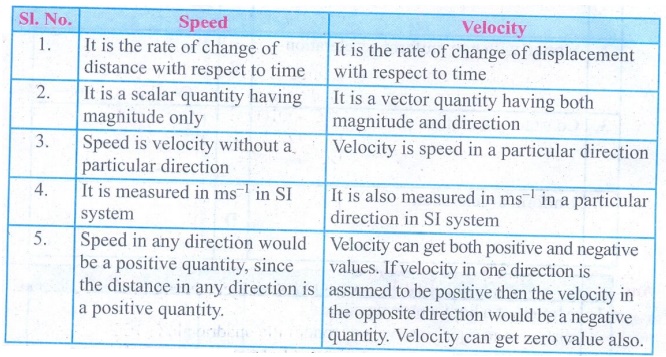
Speed
1.
It is the rate of change of distance with respect to time
2.
It is a scalar quantity having magnitude only
3.
Speed is velocity without a particular direction
4.
It is measured in ms-1 in SI system
5.
Speed in any direction would be a positive quantity, since the distance in any
direction is a positive quantity.
Velocity
1.
It is the rate of change of displacement with respect to time
2.
It is a vector quantity having both magnitude and direction
3.
Velocity is speed in a particular direction
4.
It is also measured in ms-1 in a particular direction in SI system
5.
Velocity can get both positive and negative values. If velocity in one
direction is assumed to be positive then the velocity in the opposite direction
would be a negative quantity. Velocity can get zero value also.
5. What do you understand about
negative acceleration?
Answer:
If
velocity decreases with time the value of acceleration is negative.
Note: Negative
acceleration is called retardation or deceleration.
6. Is the uniform circular motion
accelerated? Give reasons for your answer.
Answer:
When
an object is moving with a constant speed along a circular path, the change in velocity
is only due to the change in direction. Hence it is accelerated motion.
7. What is meant by uniform
circular motion? Give two examples of uniform circular motion.
Answer:
When
an object moves with constant speed along a circular path, the motion is called
uniform circular motion.
Example:
1.
The Earth moves around the Sun in the uniform circular motion.
2.
The Moon moves in uniform circular motion around the Earth.
VII. Answer in detail:
1. Derive the equations of motion
by graphical method.
Answer:
Equations
of motion from velocity - time graph:
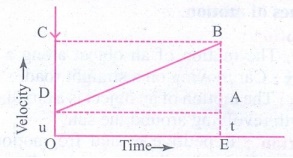
Graph shows the change in velocity with time
of a uniformly accelerated object. The object starts from the point D in the
graph with velocity u. Its velocity keeps increasing and after time t it
reaches the point B on the graph.
The
initial velocity of the object = u =
OD = EA
The
final velocity of the object = v = OC
= EB
Time
= t = OE = DA
Also
from the graph we know that, AB = DC
1. First equation
of motion:
By
definition, acceleration = change in velocity / time
=
(final velocity − initial velocity) / time
=
(OC−OD)/OE
a = DC/OE
a = DC / t
DC
= AB = at
From
the graph EB = EA + AB
v = u + at ………(1)
This
is first equation of motion.
2. Second equation
on of motion:
From
the graph the distance covered by the object during time t is given by the area
of quadrangle DOEB
s
= area of the quadrangle DOEB
=
area of the rectangle DOEA + area of the triangle DAB
=
(AE × OE) + (l/2 × AB × DA)
s = ut + 1/2(at2) …………(2)
This
is the second equation of motion.
3. Third equation
of motion:
From
the graph the distance covered by the object during time t is given by the area of the quadrangle DOEB. Here DOEB is a
trapezium. Then,
s = area of trapezium DOEB
= 1/2 × sum of length of parallel side × distance
between parallel sides
=
1/2 × (OD+BE) × OE
S=1/2×(u+v) × t
Since a = ( v
- u )/ t or t =( v - u ) / a
Therefore s = 1/2 × ( v + u ) × ( v – u ) / a
2as = v2
_ u2
v2 = u2 + 2 as ……….(3)
This
is the third equation of motion.
2. Explain different types of
motion.
Answer:
Different types of motion:
(i) Linear motion: The
motion of an object along a straight line is known as linear motion. Ex: Car moving on a straight road.
(ii) Circular
motion: The motion of an object is a circular path is known as
circular motion. Ex: Earth revolving
around the sun.
(iii) Oscillatory
motion: Repetitive to and fro motion of an object at regular interval
of time is called as oscillatory motion. Ex:
Motion of pendulum of a clock.
(iv) Random motion: The
disordered or irregular motion of a body is called random motion. Ex: Movement of fish under water.
VIII. Exercise Problems:
1. A ball is gently dropped from
a height of 20 m. If its velocity increases uniformly at the rate of 10ms-2,
with what velocity will it strike the ground? After what time will it strike the
ground?
Answer:
Here
we have
Initial
velocity, u = 0
Distance,
s = 20 m
Acceleration,
a = 10m/s2
Final
velocity, v = ?
Time,t
= ?
a) Calculation of
final velocity, v
We know that, v2 = u2
+ 2as
v2
= 0+2 ×10 m/s 2
× 20m
v2 = 400 m2/s2
=√ [400m2
/s2 ]
v =
20 m/s
b) Calculation of
time, t
We
know that, v = u + at
20 m/s
= 0+10 m/s2 × t
t = (20m/s2) / (20m/s) =2s
∴ Ball will strike the ground at a
velocity of 20 ms−1
Time
taken to reach the ground = 2s.
2. An athlete completes one round
of a circular track of diameter 200 m in 40 s. What will be the distance
covered and the displacement at the end of 2 m and 20 s?
Answer: Here we
have
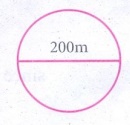
Diameter = 200 m
∴ Radius =
200 m/2 = 100 m
Time
of one rotation = 40 s
Time
after 2m 20 s = 2 × 60 s + 20 s = 140s
Distance
after 140s = ?
Displacement
after 140s =?
Circular
track with diameter of 200m
We
know that, velocity along a circular path = circumference / time
v = 2πr / 40s
v = [2 × 3.14 × 100m] /
40s
v = 628m /40s
v =
15.7 m/s
a) Distance after
140 s
We
know that, distance = velocity × time
Distance = 15.7m/s × 140s
= 2198 m
b) Displacement
after 2 min 20 s i.e, in 140 s
We
know that, distance = velocity × time
Since,
rotation in 40s = 1
∴ Rotation in 1s = 1/ 40
∴ Rotation in 140 s = 1/40
× 140 = 3.5
∴ In 3.5 rotation athlete
will be just at the opposite side of the circular track.
i.e.
at a distance equal to the diameter of the circular track which is equal to
200m
∴ Distance covered in
2min 20 s = 2198 m
Displacement
after 2min 20s = 200 m
3, A racing car has a uniform
acceleration of 4ms−2. What distance it covers in 10s after the
start?
Answer:
Here we have
Acceleration,
a = 4 m/s2
Initial
velocity u = 0
Time t = 10 s
Distance
(s) covered = ?
We
know that, s = ut +1/2 at2
s
= (0×10s) + [l/2×4m/s2 × (10 s)2 ]
=
1/2 × 4 m/s2 × 100s2
=
2 × 100m = 200 m
Thus,
racing car will cover a distance of 200 m after start in 10s with given
acceleration.
Intext Activities
ACTIVITY - 1
Look around you. You can see many
things: a row of houses, large trees, small plants, flying birds, running cars
and many more. List the objects which remain fixed at their position and the
objects which keep on changing their position.
Solution:
1.
Row of houses, large trees, small plants are the examples, of immovable
objects.
2.
Flying birds, running cars and buses are the examples of movable objects.
Activity to be done by the students themselves
ACTIVITY-2
Tabulate the distance covered by
a bus in a heavy traffic road in equal intervals of time and do the same for a
train which is not in an accelerated motion. From your table what do you
understand?
The bus covers unequal distance
in equal intervals of time but the train covers equal distances in equal
intervals of time.
Solution:
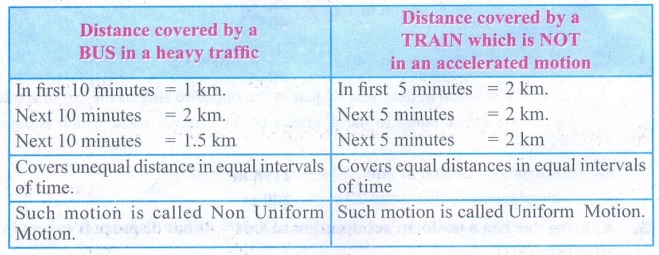
ACTIVITY - 3
Observe the motion of a car as
shown in the figure and answer the following questions:
Compare the distance covered by
the car through the path ABC and AC. What do you observe?
Which path gives the shortest
distance to reach D from A? Is it the path ABCD or the path ACD or the path AD?
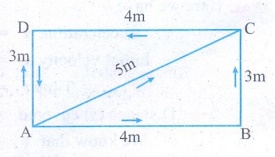
Solution:
1.
Distance covered by the car through the path ABC = 4m + 3m = 7 m. and AC = 5 m.
The distance covered by the car through the path ABC is large compared to AC.
2.
The shortest distance to reach D from A is path AD = 3m.
3.
The total distance covered by the car ABCDA = 14 m. It finally reaches to A.
ACTIVITY - 4
Take a large stone and a small
eraser. Stand on the top of a table and drop them simultaneously from the same
height? What do you observe? Now, take a small eraser and a sheet of paper.
Drop them simultaneously from the same height. What do you observe? This time,
take two sheets of paper having same mass and crumple one of the sheets into a
ball. Now, drop the sheet and the ball from the same height. What do you observe?
Solution:
Both
the stone and the eraser have reached the surface of the Earth almost at the
same time.
The
eraser reaches first and the sheet of paper reaches later.
The
paper crumpled into a ball reaches ground first and plain sheet of paper
reaches later, although they have equal mass. It is because of air resistance.
The magnitude of air resistance despends on the area of object exposed to air.
So the sheet of paper reaches later.
Related Topics